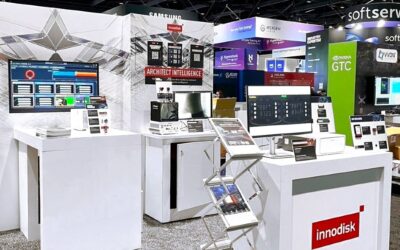By Kiran Vishal (KV) Thanjavur Bhaaskar, Manager, Marketing & Strategy – Industrial, Vision, Healthcare & Sciences, AMD AECG
Digital transformation is critical for industrial businesses, to remain competitive and deliver value for customers. Early manifestations of this trend include converging operational and information technology networks, deploying predictive maintenance, and automation using robots to raise throughput and eliminate human errors.
Product developers need to deliver solutions to these challenges quickly. A programmable system on module SOM can provide a suitable computing platform on which to start. However, additional firmware and software infrastructure are needed and a heterogeneous processing engine and integrated programmable logic can add valuable flexibility. Analysing some known SOM-based solutions used in network convergence, predictive maintenance, and robotics can highlight the areas where these additional resources can accelerate development and help ensure optimum performance.
Solution for Network Convergence
Converging Information Technology (IT) with Operational Technology (OT) networks eases the flow of information between systems in the factory floor and the enterprise-level management and strategic decision-making activities; it enables end-to-end communication from the lowest sensor/drive, all the way to the Enterprise Resource Planning (ERP) system. Convergence also eliminates overheads associated with managing two networks.
IT and OT networks have very different requirements. OT networks require real time, low-latency communications and are difficult to scale. IT networks, on the other hand, are easier to scale but not deterministic or provide a guarantee of service. Time Sensitive Networking (TSN), a subset of IEEE 802, facilitates convergence by enabling deterministic communications over Ethernet networks. By providing network management as well as allocating time-defined slots for scheduled traffic, TSN enables different classes of traffic to share the same link.
Correctly implementing TSN requires a solution that can provide a low latency and deterministic response at network endpoints and switches. A suitable platform would comprise an Ethernet MAC, TSN bridge, and TSN endpoint logic (figure 1), as well as software to handle functions like network synchronisation, initialisation, and interfacing with network configuration controllers.

Figure 1. SOM-based TSN endpoint. AMD Xilinx’s TSN IP core implements these elements using both the programmable logic and processing system of the Kria™ K26 SOM, which contains a Zynq® UltraScale+™ MPSoC. This IP core provides individual interfaces for each traffic class and can be configured with up to two ports that transport all traffic classes over the same cable or fibre.
Predictive Maintenance
Predictive monitoring lets equipment operators pre-empt failures and schedule maintenance to happen at convenient times, thereby maximising utilisation and uptime while minimising ownership costs. Implementations can range from cloud-based digital twins to prognostics at the edge for monitoring simple drives and sensor systems. Processing at the edge and communicating the processed data to the cloud is the most viable solution for many industrial applications due to the volume of data and the resulting critical response time of the decision loop. The use of prognostics at the edge can provide significant benefits. For example, operational failure of a CNC machine’s spindle can result in a significant impact in costs not only from the damage caused to the CNC machine, but also from the halt in production.
A key challenge, when building such systems, lies in developing machine-learning applications for deployment at the edge. A suitable toolkit can help tackle this by providing ready-to-use deployable high-performance machine-learning algorithms that enable developers to build their applications using popular machine-learning frameworks such as PyTorch, TensorFlow, and Caffe.

Figure 2. Developing machine-learning applications using a SOM with industry-standard frameworks. Vitis™ AI tools provide a large selection of Deep Learning Processor Units (DPUs) as parameterizable IP cores that are implemented directly in the SOM programmable hardware (figure 2). Starter kits like the KV260 Vision AI Starter Kit include AI-accelerated applications that leverage the Vitis DPUs.
ROS 2-based Robotics
One of the most critical technologies for Industry 4.0 is the use of robotics to automate the production process. In manufacturing, these solutions can cover a wide range of applications from robotic arms working on a production line, to robots moving supplies and logistics around the manufacturing floor.
A high-performance, low-latency processing system is critical to interact with the environment safely. In particular, it is needed to control the robot’s moving parts, which comprise complex systems of actuators, drives, and mechanics often called mechatronics. Because robots communicate internally using networks to achieve the required real-time control, a SOM that contains programmable logic brings two advantages. One is the ability to support any-to-any interfacing, which simplifies implementing connections to sensors and drives. Moreover, programmable logic can be used to implement deterministic networks, which is critical for the implementation of robot systems.
Many development projects leverage the Robot Operating System (ROS), which comprises a set of software libraries and tools for creating robot systems. While ROS has been recently updated to ROS 2, its native Continuous Integration/Continuous Delivery (CI/CD) development pipeline is designed explicitly for homogeneous CPU-based processing systems.
In addition, monitoring and automation are added to the CI/CD pipeline to improve the process of application development, particularly at the integration and testing phases and during delivery and deployment. This automation minimises the manual execution of each of the steps of a CI/CD pipeline and roboticists to use the same conventions of ROS 2 with the same tooling for parts that are implemented in software or that are offloaded or accelerated in programmable logic.
There is also a mechanism to benchmark the execution of a ROS 2 node application, which helps identify bottlenecks and specifically tailor one or more kernels as offloaded kernels in programmable logic.
High-performance adaptive edge computing is a pillar of industrial digital transformation. Programmable SOMs can simplify the creation of flexible, adaptive computing solutions and, with purpose-designed IP including software stacks, can accelerate the development of a production-ready model.





